Monday Must Reads: Volume 26
This blog post contains Amazon affiliate links. As an Amazon Associate, I earn a small commission from qualifying purchases.
Happy Monday! It’s a three-day weekend here, so I’m especially enjoying this Monday that feels more like a Sunday. Today, I have knocked out our grocery shopping (a much-hated chore) and stopped by a few thrift stores where I picked up some new books. I had lunch with my parents and sister, and now I’m sitting on my couch covered up with a blanket while I finish off this post. After I hit Publish, I need to figure out what my Algebra students are doing tomorrow and continue working on a 2.5 hour presentation I will be giving Saturday over interactive notebooks.
If you’re new around here, I try to share a new post every Monday of the previous week’s “must-reads.” It’s really just an excuse to scroll back through my twitter likes of the previous week and think about how I would like to apply them in my own classroom. I hope you can take away something useful from this post!

Without further ado, here are this week’s must-reads!
Child Pedestrian Fatalities Graph
One area where I fall short in my classroom is exposing my students to real-world data and real-world situations. It’s an area where I’m always striving to improve, but I always still feel like I’m falling short. One of the main reasons this area is hard is because it’s hard to find good data to use in the classroom that will capture students’ interest. This graph that was shared on twitter by Trooper Ben caught my eye. I’d love to edit it a bit (especially remove the Halloween label) and use it as a What do you notice? What do you wonder? prompt. Would your students be able to tell why there was a dip at the end of February and a peak at the end of October?
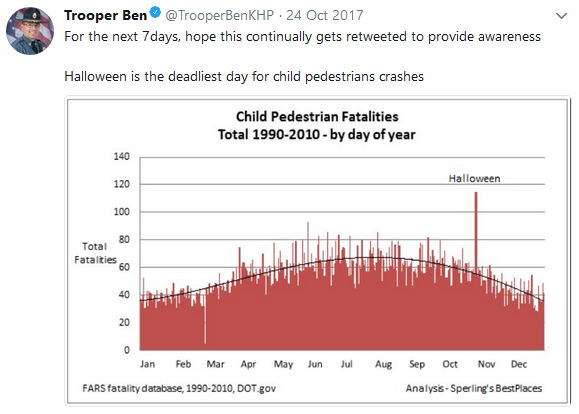
Exponents Misconception
Jo Morgan shared a common misconception that her students have with evaluating expressions involving exponents. My students have been having similar issues. Despite going over the order of operations in depth at the beginning of the year, they are still making errors like this. I even make my students sign a “Parenthetical Promise” where they have to pledge to always use parentheses when substituting values into an expression. Still, I get responses like this. How would your students answer this question? I think we need to have more conversations about common misconceptions like this.
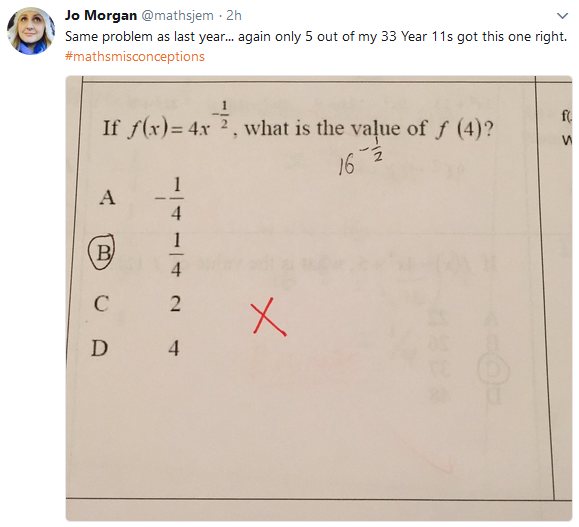
Dilations Mystery Picture
Teaching dilations? Check out this idea from Adam JW Craig‘s coworker. You could easily use a different mystery picture with each class so that one class couldn’t ruin the mystery for another class.

Horizontal and Vertical Line Art
We’re currently working on linear graphs and inequalities in Algebra 1, so I’m especially on the lookout for ideas for this unit. Amy‘s Special Lines Drawing assignment caught my eye. I’ve done this with slope before, but I never thought of doing it with writing the equations of horizontal and vertical lines.
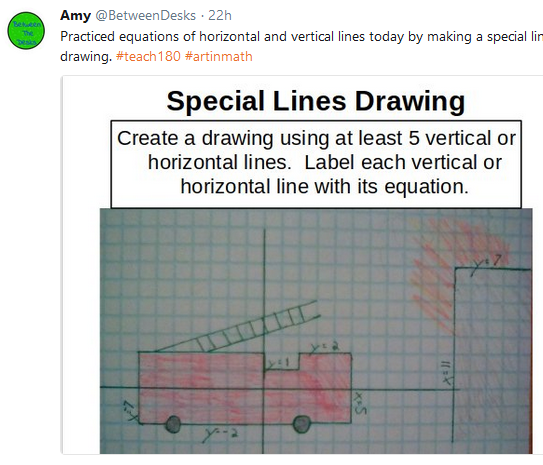
Chemistry WODB
The chemistry teacher in me also loves Amy‘s Which One Doesn’t Belong task.

Prime Number Conjecture
Students often amaze us when we just give them time to think and ponder in class. I love this conjecture about prime numbers created by c_lum dill_n.
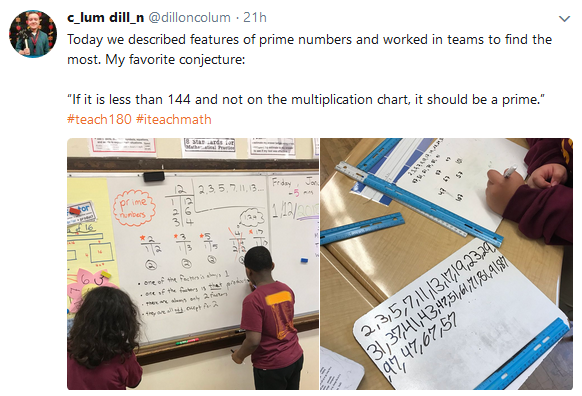
Linearity Slope Task
Paul Jorgens offers a brilliant activity for introducing the idea of linearity. Totally stealing this idea for next year!
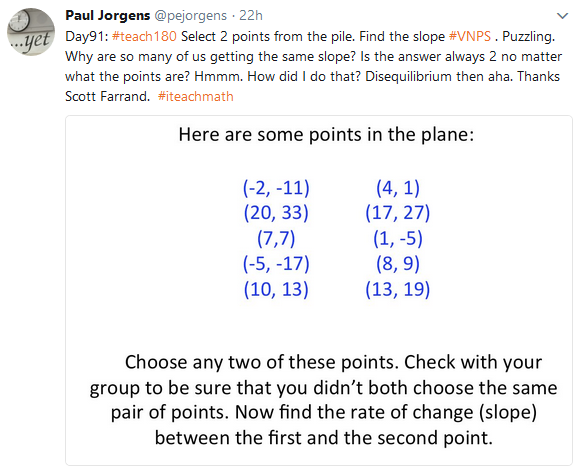
Different Representations of Functions Activity
Julia Anker is helping me write my lesson plans for one of my skills later in our linear graphs and inequalities unit with this activity. Each student had either a situation, table, graph, or equation for a function taped to their back. They had to ask each other questions in order to place themselves in groups that represented the same function. What an awesome idea!
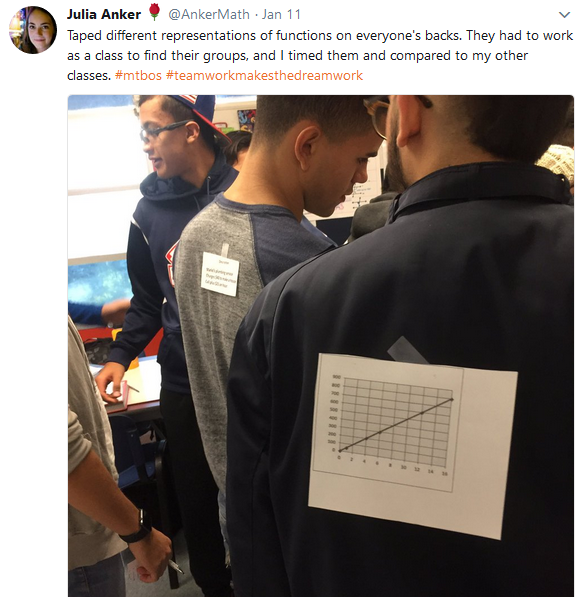
Gummy Bear Statistics
Jennifer Michaelis shares a link to an interesting NPR article regarding a study involving gummy bears and several related studies which I found to be quite interesting. Do gummy bears of different colors really taste different? Can your students devise a study to test their hypothesis?

Hidden Math in a Gingerbread House
Lauren Hannah creates a yearly gingerbread house with one goal in mind: to have her students find as much math hidden in the gingerbread house as possible. I LOVE this idea!
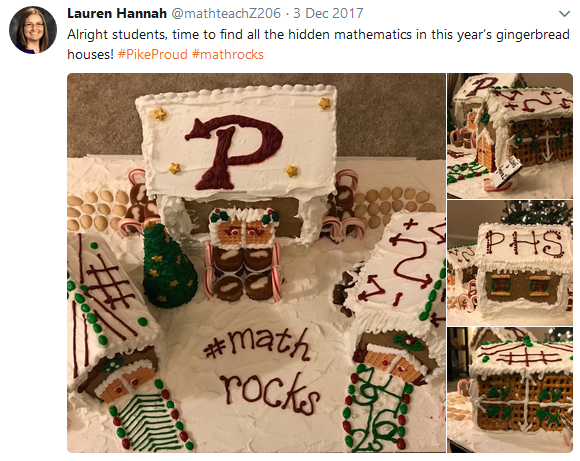
Mystery Footprint Scatterplot
Sarah Leivian shares the results of a “Mystery Footprint Project” that sounds like the perfect motivation to introduce scatterplots.
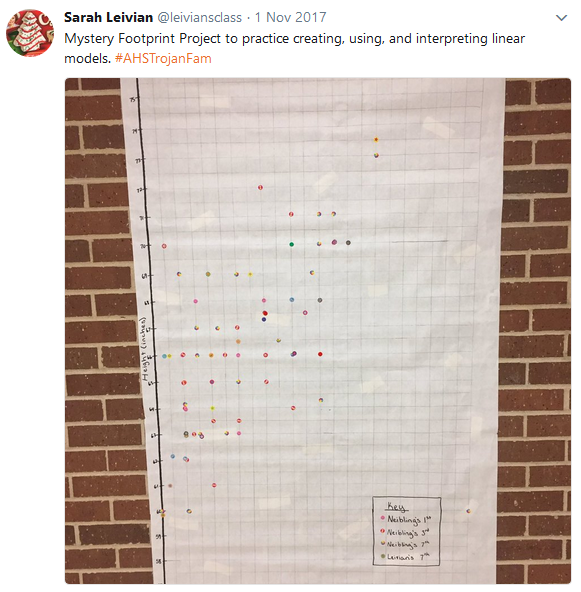
The Battle of the Christmas Cakes
I also love Sarah‘s project where she challenged her students to come up with a strategy to determine if Zebra Cakes or Christmas Tree Cakes are better. How fun is this?!?

Panda Square Free Play
Molly Rawding shares a fun twist on Panda Squares. Instead of giving directions at the beginning, allow for free play to see what people come up with. Great idea!
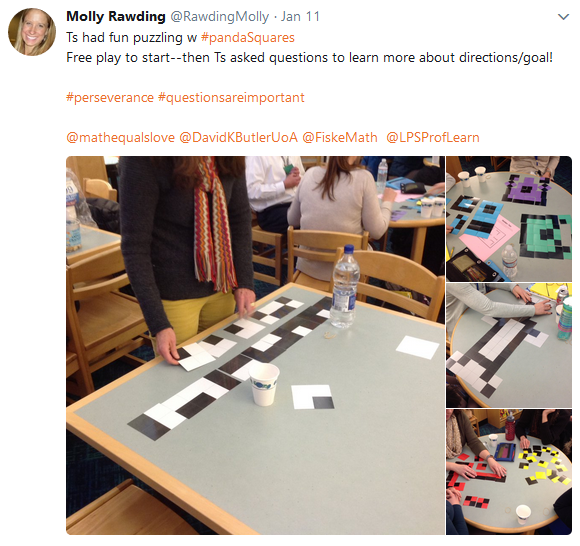
Tug of War Prediction
I’m currently in the process of teaching myself physics so I can be certified to teach physical science and/or physics, so I’m always looking for great physics activities. I love this tug of war activity to motivate coefficient of friction from Frank Noschese.

Destress Corner
It is true. Students are stressed. So, I think it’s amazing that Cynthia Platou added a de-stress corner to her classroom that features a giant coloring page. Cynthia says she bought her color poster awhile ago at Hallmark.
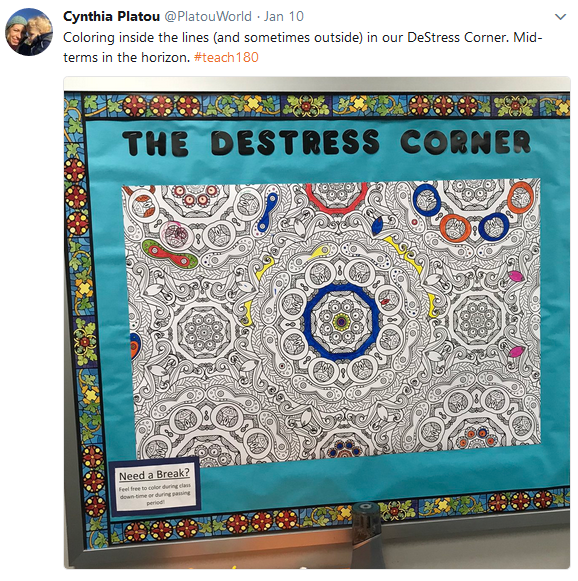
Non-Negotiable Rules
Scottie O’Neill shares a great idea for making classroom management more manageable. I think I need to do this next year. I need to pick a couple non-negotiable rules and track them visibly.

Exit Ticket Twist
I’m also intrigued by this twist on exit tickets that Scottie has shared.
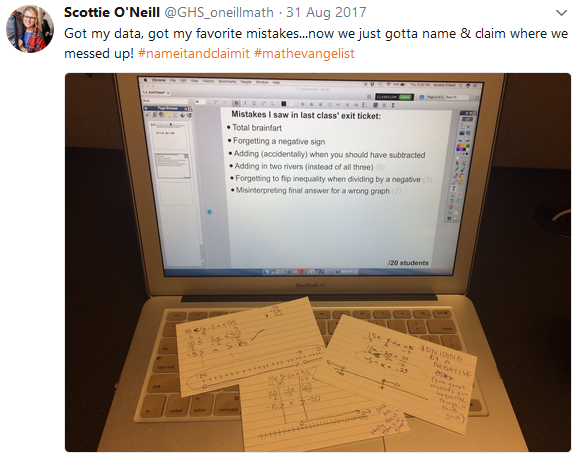
Area and Volume Challenge
Looking for a challenge for your play table/puzzle table? Tara Daas has got you covered. This is perfect for me because I just ordered a class set of base ten blocks earlier this year.
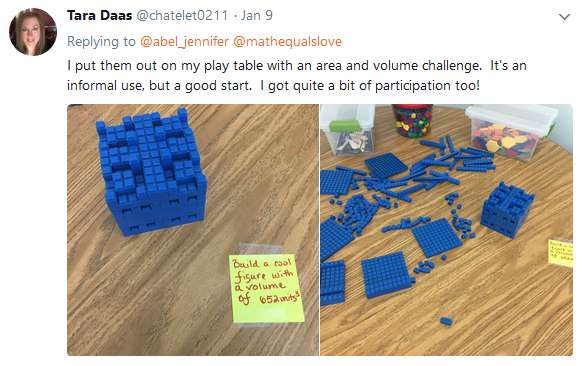
Snow Date Prediction
Looking to have some snow day fun? Liz Mastalio puts up a calendar and gives each student a chance to guess when the first snow day of the year will be. I know this is probably too late in the yar for most of you, but here in Oklahoma we still haven’t had a snow day yet.

Giant Ten Frames on Floor
Jenn Vadnais shares a photo of giant ten frames on a classroom floor. This has my brain churning about what other giant math-y things we could make on the floor of our classrooms…
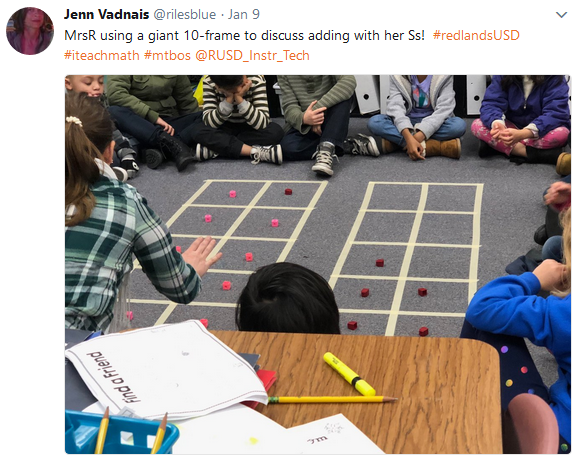
Expanding Creatures
Chris Bolognese has came up with a great idea for investigating similarity – expanding creatures!
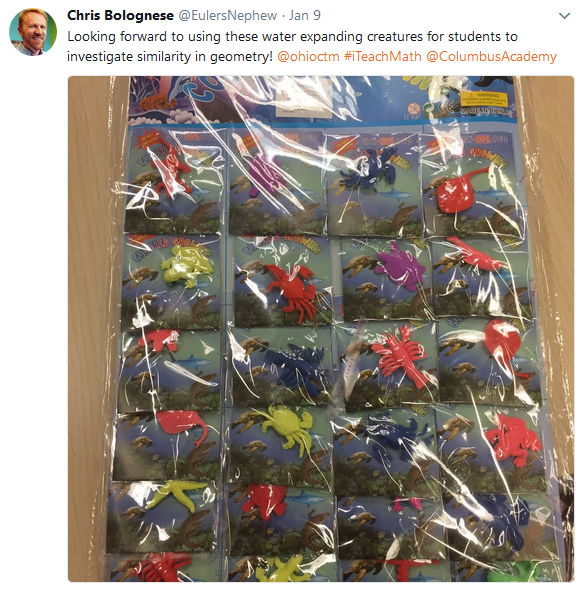
Graphing Trig Functions with Wrapping Paper
Have any leftover wrapping paper that has a grid on the back? Daniel Knox has a use for that.
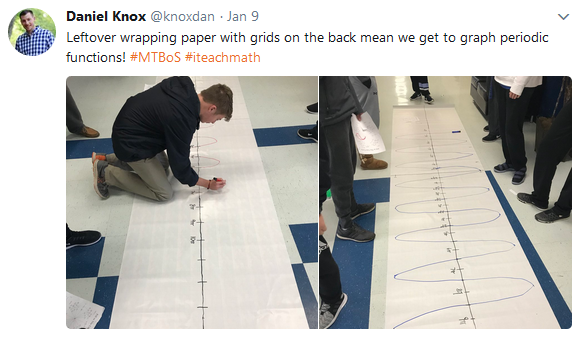
Special Quadrilaterals Card Sort
I can’t not share this awesome card sort created by my husband, Shaun Carter, for his geometry classes. See why I married this guy?!? You can find this activity on Shaun’s blog.
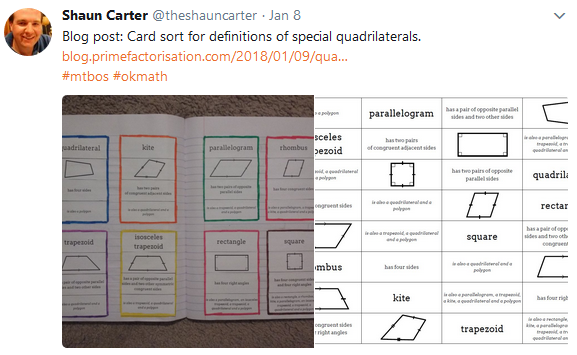
Graphing Winter Break
What better activity for the first day back from break than creating and illustrating a graph that describes how you spent your break? Thanks Trever Reeh for the great idea!

Hands-On Stoichiometry
Megan Denman shares an idea for an awesome way to make stoichiometry calculations more hands-on with a card sort.
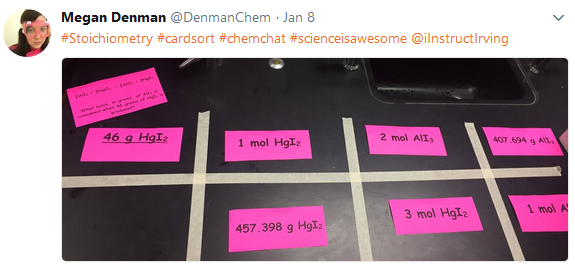
Equilateral Triangle Task
Mr. Knowles shares a great looking geometry task that involves a lot of algebra practice. I would classify this as a very strong first tweet for a beginning teacher! I look forward to following this account to see what other excellent tasks that Mr. Knowles has to offer.

Algebra Tiles Artwork
I love using algebra tiles, so I was super excited when I ran across a creative algebra tiles art task from Jazmine Castanon on my twitter feed.

3D Printing from Desmos
Leigh Ann Mitchell shares an awesome project that combined graphing with Desmos and 3D printing.
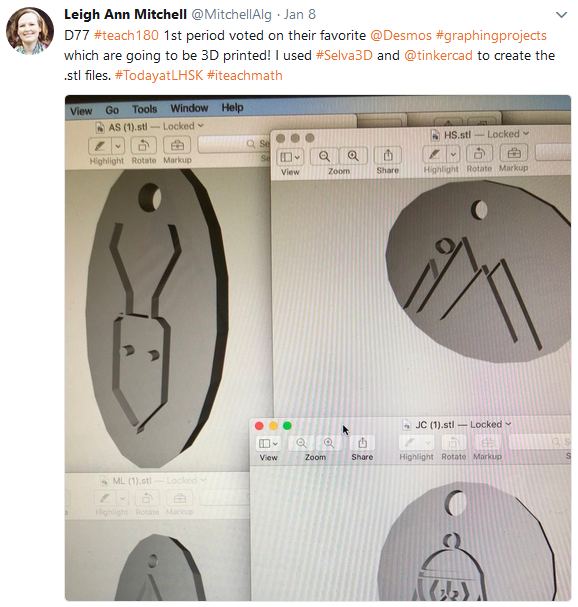
Left Center Right with Integers
I love playing Left Center Right with my students, so I was super excited to see that Sandra Hinckley had math-ified the game a bit using positives and negatives.
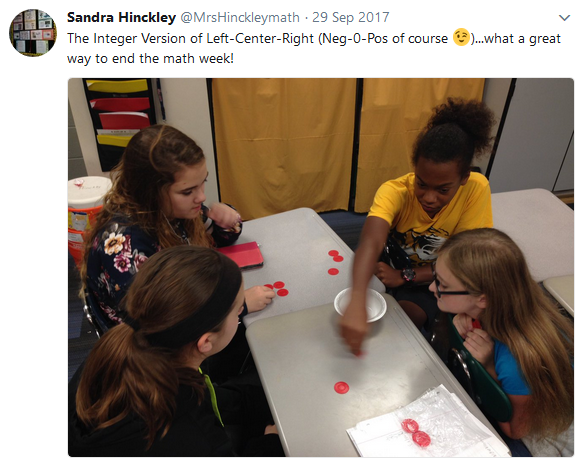
2018 Puzzles
Amy Hogan shares some fun 2018-themed math puzzles to help ring in the new year.

Until next week, keep sharing your ideas!


Help out a puzzled Aussie! What happens at the end of February? (Re Trooper Ben's graph).
Hint: an Australian graph would have a similar dip!